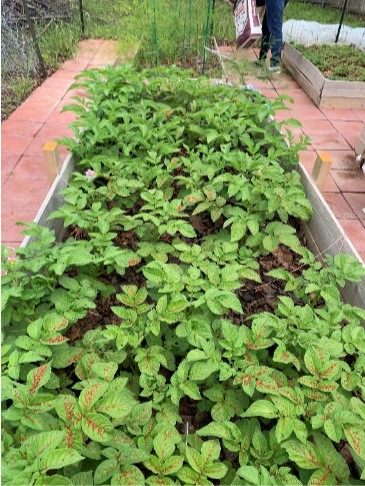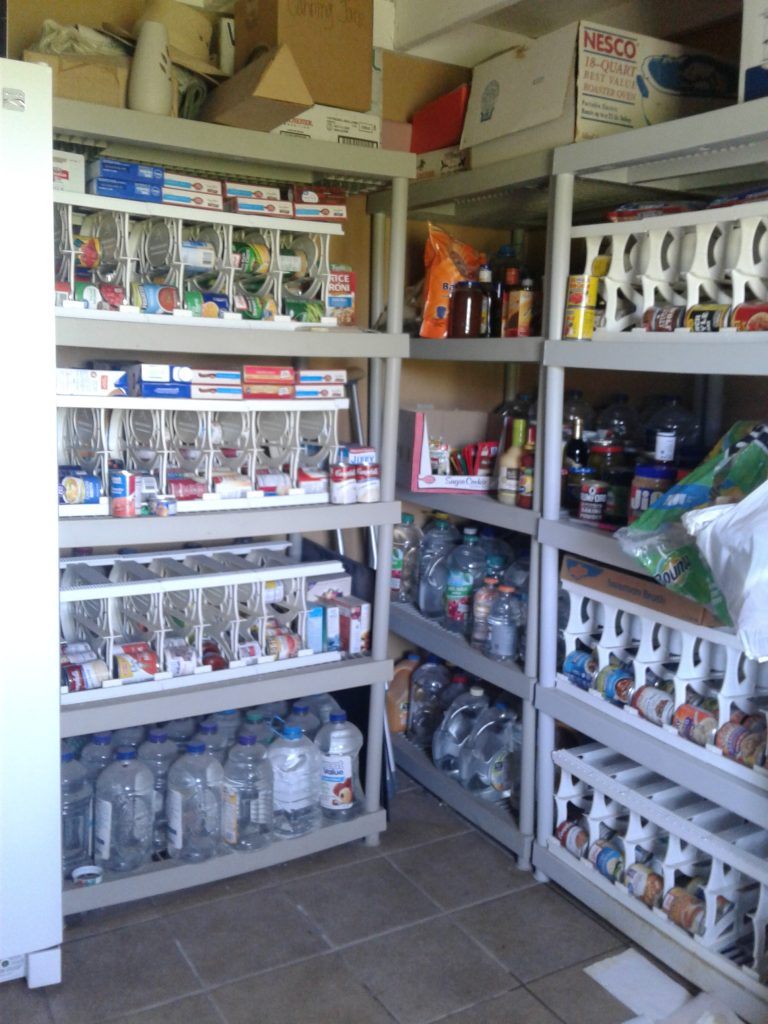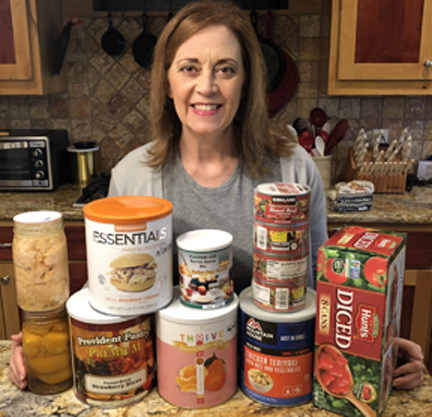Five Preparedness Experts Share Experience During COVID-19 Pandemic
Featured Photo: Personal preparedness expert Catherine Fredericksen displays food storage building blocks. Photo courtesy of Catherine Fredericksen
Gobsmacked by COVID-19? If you’ve found yourself unprepared for the 2020 coronavirus pandemic, you are not alone — as no doubt you’ve noticed while battling for the last roll of toilet paper at the local Piggly Wiggly.
The good news is it’s not too late to prepare for the next crisis. The next crisis? Yes, the next crisis is that puffy white cloud on the horizon today, nothing at all to worry about, until the storm breaks over your head.
So how do you prepare for hard times a’coming?
Meet five North Texas preparedness experts who have opened their cupboards of vast experience to help you and your family to be better prepared, come what may. Between them, they have nearly 100 years of home storage and personal preparedness experience. They will share resources and links at the end of this article to help you get started:
Gavin Hutchins, a Texas transplant from Nebraska, a 30-year veteran of personal preparedness, and veritable survivalist encyclopedia
Catherine Fredericksen, an eighth-generation Texan and ten-year home storage advocate
Myrna St George, a forty-five-year resident of North Texas with ten years of experience in the home storage trenches
Duana Blakey, a Texan since 1971 with ten years home storage experience
Brenda Cluff, a native Texan with 14 years homes storage experience
All belong to The Church of Jesus Christ of Latter-day Saints, which has been advising its members since the early 1800s to ” ‘prepare every needful thing’ so that, should adversity come, we may care for ourselves and our neighbors.” The Church is itself a vast resource for home storage information (Provident Living). All of our experts have cited their faith as a reason for their focus on home and personal preparedness.
Why do you prioritize home storage?
CF: My mother took home storage very seriously and was always helping people with acquiring storage items and learning how to use them. I saw the value of her efforts when a flood happened in the small town we lived northwest of San Antonio when I was a high school freshman. My parents gave away much of our food storage to families who had lost everything. [. . .] I actually enjoy it. It gives me a feeling of security and satisfaction that I know how to feed my family during a crisis, and I wanted to share that knowledge and secure feeling with others. Over time, I teamed up with other like-minded individuals to share our knowledge and group [order] offers to a broader audience across the DFW area. Being a SAHM [Stay at Home Mom] gave me the opportunity (“free time”) to be “anxiously engaged in a good cause,” and I’d believe the Lord has been pleased with my efforts.
GH: [As I understand basic human nature and the philosophies of men], my opinion is it’s prudent, and based on my own life experiences, it is wise. I have been all over the world and have seen how societies and governments function. Self-reliance just makes a lot of good sense. How can you help others if you can’t help yourself?
DB: It gives me peace of mind. The more I learn about emergency preparedness, the more I realize how important it is for peace of mind and to get you through tough times.
BC: First, my parents have always had food storage, as did my grandparents. I guess I grew up with that example, so I wanted to do it, too.
MS: First and foremost, to follow the Prophet’s guidance. Secondly, because it works and helps us be prepared for just about anything.
Would you call yourself a “prepper”?
GH: Yes, absolutely.
CF: Nope. “Prepper” denotes a certain image that is not who I am. I just think of it as being self-reliant and a good citizen. It’s just part of my regular lifestyle. I don’t want to have to rely on others when my family is capable of providing for ourselves.
DB: I think most people would call me that, but I am not like the doomsday preppers you see on TV. I’m just trying to be prepared and not scared of what may happen. Having peace of mind during an emergency is worth more than money.
MS: Not to the extreme some take it, but we ARE trying to get off the grid and get our food storage and 72-hour kits better organized.
BC: There are definitely areas where I’m weak, and I plan to become more of a “prepper” over time. But, yes, I’d say I’m on the “prepper” end of the spectrum.
Is the COVID-19 pandemic the first time you have had to rely on your home storage?
CF: Yes, and no. I’m a believer in using what you store, so I regularly use my wheat, for example. I make whole wheat bread and pancakes that my family loves! (I also make homemade berry syrup to go with the pancakes!) Some items I can leave in storage and not use, but I want to know what to do with my storage in the event I have to use it, so I try some items, and I have several reference books, too. When my husband lost his job a few years ago, he had a severance package, so we did not need to use our food storage, but if he had not found new employment, I was prepared to start when the severance package ended.
GH: I maintain a well-stocked “pantry,” so I have not had to rely exclusively on just my food storage. My preparation transcends food, clothing, and all other basics. I have weathered multiple hurricanes and other natural disasters.
MS: We use our home storage almost daily — pandemic or no. That way, we rotate it better. We’re told to store what we eat, and that’s what we do.
DB: No, I have used it in months where the electric bill was really high, and my food budget was really low.
BC: We try to rotate our storage, so you could say that we’ve been using our home storage ever since we started building one. However, we haven’t really had to rely on it. Even now, I’m going to the store every week and getting some groceries—mostly produce. We could survive off of what we have in the house but since the stores are open, I’m happy to continue to utilize them! If we relied solely on what we already have in our storage, our dietary habits would have to change somewhat. This has been a good thing to notice.
How do you recommend people begin to become “prepared’ with home storage? Procuring a year’s supply of food and necessities is an overwhelming thought. The cost, the room to store it all. How do you do it?
CF: It’s like the proverbial “eating an elephant”: a little at a time! It is so much easier now for people to get started. There are books and websites for every kind of preparedness level, from the basics to “advanced prepping.” As a member of The Church of Jesus Christ of Latter-day Saints, I belong to a community that supports and encourages preparedness. Our Church website has a preparedness website for Church and public use Provident Living. In addition, several members of the Church have preparedness blogs (not official sites of the Church, of course—they’re just doing their part to share their knowledge, too). One of my favorite sites is foodstoragemadeeasy.net. Their “Baby Steps” program is awesome! They also have a long-term food storage calculator that can be personalized to help determine how much to store for any family. (I don’t get anything from endorsing them!) Another great source is Ready.gov. The main thing is: do not get overwhelmed and think it has to be done in a day or even a month. Just incorporate an allowance for storage items into your budget and do something every month. Make a plan, shop sales, participate in group orders, and watch your storage grow! Start with a 72-hour kit for sure! Ready.gov is the place for that information.
GH: I have been blessed with the ability to add [food storage] over time. Sometimes more or less when I have resources to do it. I have one dedicated room for some items, but there are plenty of “nooks and crannies” in any building to store things. You can add small staple items over time to cover a year’s worth of supplies.
MS: Start simply. We started with soups and vegetables. We also used as a guideline the attached “calendar” as a suggestion, and sometimes added those items plus one or two extra cans of soups and veggies. Procuring a year’s supply of food and necessities is an overwhelming thought. If you follow the calendar exactly, at the end of the year, you will have enough food for four people. The cost, the room to store it all. How do you do it? One of the first things we did was purchased shelving and can holders with an income tax refund. We already had a small bit of storage, but when we got the shelving, it was easier to do. We’re lucky in that we had a large mudroom, and that’s where we store it.
BC: Well . . . I can’t say that I do this, at least not completely. We couldn’t survive for a year, I admit. But, I’m so much more prepared than I would have been had I never taken the first steps! I started by simply purchasing a couple of extra cans of food every time I went to the store. Then, I learned how to do dry pack storage, purchasing a simple $30.00 device that allowed me to vacuum the air out of jars that I already had on hand (such as old pickle and salsa jars). Next, I bought a Sun Oven on a group order and started to tinker with using it. Later, [I got] a steam canner and a pressure canner. [Then,] I started to store water in our garage, using old juice and soda pop bottles. Over time, I acquired some 50-gallon water drums (used, so I needed to clean them out). Realizing that for the water in the drums to be drinkable and wanting even our current supply of water to be less chlorinated, I did some online study and invested in a high quality (but simple and affordable) water filtration system.
During this time, I signed up to be on local emergency preparedness email lists so that I could participate in group orders, where it made sense, such as Rainy Day Food orders. I started a garden, attended local gardening classes, and purchased a book or two to help. To summarize: 1) I took baby steps in both investment and in learning; 2) I sought help from others who had more experience than me, and 3) I took advantage of local classes, email lists, and opportunities to learn more.
DB: It can be overwhelming at first, so take it a step at a time. Work on getting your 3-month pantry supply first. These are the foods you eat every day. The best recommendation I have heard for that is to plan out seven breakfasts, seven lunches, and seven dinners you know your family will eat. Go through the recipes and write down the ingredients you will need and how much. Then multiple by four for a month and then that by three for three months. You want to store shelf-stable foods.

Also, starting a garden is a good idea. If you have never gardened and just store seeds “in case you need them,” you will be out of luck. Gardening has a big learning curve, and it can be expensive to get started. We do not have the best soil in Texas, but there are lots of good ways to get around that.
After that, you work on your longer-term storage. The cheapest place to start that is with The Church of Jesus Christ’s Home Storage Centers. Our local one is in Carrollton. It is open to anyone; you don’t have to be a member of the Church.
Ask to join the North Texas Preparedness Group Facebook page. We share articles on different things, info on orders we are doing and is a great place to ask a question.
I do a monthly email where I collect 20 articles on a topic and share the link on the Facebook page. For March, that was Pandemics. In April, it will be on food storage -how to store, what to store, where to store, etc.
Here is a link to Texas A &M Agrilife Extension Gardening in North Texas
What is the most essential item to store?
GH: Water; can’t live without it. Have to be prepared to filter water sources to survive; a lot easier today with all of the “gadgets” that are cheap and easy to get.
CF: Water would be number one, but aside from that, every home should have a 72-hour kit for each person and pet. Ready.gov is the place to learn about this!
MS: Toilet paper!
BC: This one is easy: Water, hands down, no question. If the water isn’t pure, then water plus a way to purify it is equally important. I have so many food storage items that wouldn’t do me a bit of good if I didn’t have water on hand. Besides, a person can survive a while without food, but we can only go three days or less without water.
DB: Water. You can only live for three days without water. And having a good source of water is critical because water-borne microbes cause a lot of bad problems that can sicken or even kill people.
Here is a link for How to Store Water
What is the most challenging item to store?
CF: The most difficult thing to store food-wise is probably water — it takes up a lot of space! But it is essential for personal hygiene, drinking, and cooking. So, in addition to water storage, a good filtration system is essential. For non-food items, fuel and/or cooking options are a challenge. You need variety so as not to be dependent on any single method. And car fuel can only be stored in small quantities, and must be rotated too!
GH: Water. Size, volume, and weight.
BC: Fresh produce—but almost any fruit, vegetable, or meat can be canned and preserved, and dry goods are very easy to store. Even cheese can be stored through freeze-drying, although one would need to purchase it already freeze-dried (or purchase a freeze drier, which is expensive!) Perhaps a good answer here would be fermented foods since they require cooler temperatures that we don’t often have here in Texas. They do best at 50-60 degrees. Dairy is also difficult to store and have it maintain its original palatability; powdered milk is pretty nasty compared to the fresh stuff.
DB: Water. It is heavy, and it takes up a lot of space. So, have as much as you can store but also have filters and other means of purifying your water. Know where you could go to get water, is there a lake or pond near you?
Do you have a 72-hour “Go Bag” prepared for each member of your family?
CF: Yes! These are the basic, essential items every person should have. [We have never had to use it], however, we rotate the “short term” food stuffs and clothing (as needed) every six months to a year. I also have long-term food items that can be rotated less frequently.
GH: [I have] several. I use my ‘go bag’ almost monthly. I’ve highly refined it based on actually living out of it for extended periods in the field and all climates.
BC: Yes, we do. We reassess our 72-hour kits every six months or every year at a minimum. They can always use some updating, and there is definitely room for improvement, but we have food, toiletries, water, emergency shelter, first aid supplies, activities for the kids, essential oils, and a vital information card for each person.
Here is a link to Emergency 72-Hour “Go Bag” List
How has your family been blessed through your efforts?
DB: Well, this COVID-19 pandemic is a perfect example. I did not have to go out and “panic buy” anything, not even toilet paper. I am in the “at risk” group because of age and health issues, so that was important to me. I am at home till this is over, and as it turns out, my sister and niece are here with me for the duration. I had not planned on that, but because I wanted to help my family as needed, I have plenty of food and supplies to get us through this.
CF: I feel the biggest blessing we have received from being prepared is that we have no fear! There are peace and security in knowing that even if my husband is out of work or there is a worldwide pandemic, we will still be able to eat. Our financial reserve will not be depleted due to purchasing food for my large family, and we can keep our home running even if we have to cut back on some things until our situation improves. As a side note, I’m also stocked up on non-food items, so I haven’t had to buy even one roll of toilet paper!
GH: We never run out of anything and can help others when they are in need.

MS: We’ve never gone hungry, which is the most obvious. However, I store cake mixes to use for baking cookies. Whenever our grandson comes over, he bakes them. He’s been doing this since he was about 7 — he is 15 now, and still loves to make them.
BC: We’ve never had to rely on our emergency preparedness efforts, so far. This has been a huge blessing! At the same time, however, I can’t begin to describe how empowered I feel when I learn new skills and incorporate them into daily life! For example, I feel so empowered when I use our Sun Oven to cook our dinner! Come to think of it; I did need to use our BioLite to cook our meal one evening when the power went out; that was very empowering! Last week, I pulled out some dehydrated food that had been sitting in our storage for a bit too long. Even though we didn’t really need to rely on our home storage, it felt so empowering to me to know that I could feed my children using our home storage — especially that we have plenty of water to re-hydrate our food and use for drinking, cooking, and cleaning. In short, we’ve been blessed with relative peace of mind, with a feeling of empowerment, and with skills that I can use in everyday life to bless my family. I plan to keep learning and working on expanding what we already have! I hope to be a resource to others, as well, just as others have been such great resources and support to me.
Suggested Links:
From Catherine Fredericksen
- Rainy Day Foods: (from their website) Rainy Day Foods is a privately owned corporation with its main office and store located in Montpelier, Idaho. Rainy Day Foods provides home food storage and emergency supplies. Rainy Day Foods continues to research and experiment with the technology needed to improve short and long-term storage and preservation. We at Rainy Day Foods are committed to offering our customers the highest quality of edible grains, dehydrated imitation meats, vegetables, fruits and freeze-dried products available as well as items used for storing these products and other emergency supplies.
- Emergency Essentials: (from their website) BePrepared.com is the world’s largest dedicated online marketplace for survival food, water, and gear. They’re a complete one-stop-shop for everything you need to prepare for emergencies.
- Honeyville: (from their website) Since 1951 Honeyville has grown from a local grain mill into a national food supplier specializing in the baking, cooking, and food storage industries. We strive to offer excellent quality foods at competitive prices to all of our customers no matter what your volume requirement is. Honeyville’s diverse line of products includes freeze-dried and dehydrated foods, whole grains, flours, baking ingredients, hearty foods, corn products, and much more.
- How to Begin a 3-12 Month Food Supply This is a blogpost from The Church of Jesus Christ of Latter-day Saints with very basic information about starting on longterm storage supplies. This is not a source for purchasing items.
- A Google search on “food storage how to” will yield many many helpful sites!
From Myrna St George:
- Week by Week Calendar Guide for building up a year’s supply of food and necessities: https://churchofjesuschristinnorthtexas.org/wp-content/uploads/2020/04/Food-Storage-Calendar.pdf
- https://ready.gov This is a government website that provides lots of information to prepare for just about any disaster.
- http://www.cdc.gov On this government website, you will find the latest information about the COVID-19 pandemic, other health concerns, travel guidance, and emergency preparedness.
- http://www.fema.gov For help during disasters, how to get help, and how to give help.
- http://www.redcross.org
From Brenda Cluff:
- Do You Know What To Do? This is not a home storage site as much as it is an emergency preparedness site. It has a form that we filled out with pertinent information to have on one’s person in an emergency, plus some great, simple information.
- Cultures for Health has great recipes for fermentation
- National Center for Home Food Preservation I use the USDA’s book on canning and food preservation
From Gavin Hutchins:
- Classes in Fieldcraft “I am a strong proponent of teaching fieldcraft. That is survival techniques for when you have to “rough it.” All the way from food, water, sleeping gear, shelter, what shoes to wear, socks to have, etc. I live what I teach.” For information about classes, contact Gavin at [email protected]
From Duana Blakey:
Preppers live by this motto: “One is none, and two is one.” So if something is essential, have more than one of them. The more essential, the more backups you will need.
- Home Storage Centers—The Church of Jesus Christ of Latter-day Saints
- Winco Grocers – The have things in bulk and some long term canned foods
- Healthy Traditions
Preparedness info sources:
- Preppernet This site provides lots of good training
- Backwood Homes Backwood homes https://www.backwoodshome.com/
- Ask A Prepper
- Survivopedia
- Local camping stores have lots of good items for emergency preparedness. Just think of it as an extended camping trip!
Heirloom Seed Sources:





